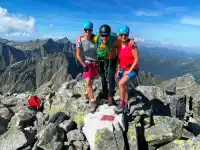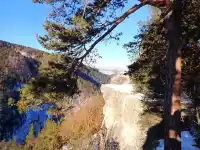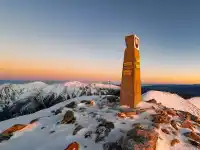When you say Blue Grotto, most travellers think of the Italian island of Capri. However, there is also an impressive Blue Grotto in Malta. The sediment and sandstone deposits between complex granite layers have sculpted an extraordinary natural spectacle of several sea caves. Although it is impossible to reach the inside of the caves by land, the Blue Grotto is an essential tourist checkpoint in Malta.
Blue Grotto reefs
The rocky cliffs form a complex of seven caves, dominated by a large rock arch falling into the sea. It can be seen from the rest area by the bus stop of line 74 from Valletta: Panorama. This is also the most frequent best off point for tourists to take photos. They arrive, click, take a boat ride and move on.
The rocky reefs in the area, however, offer much more.
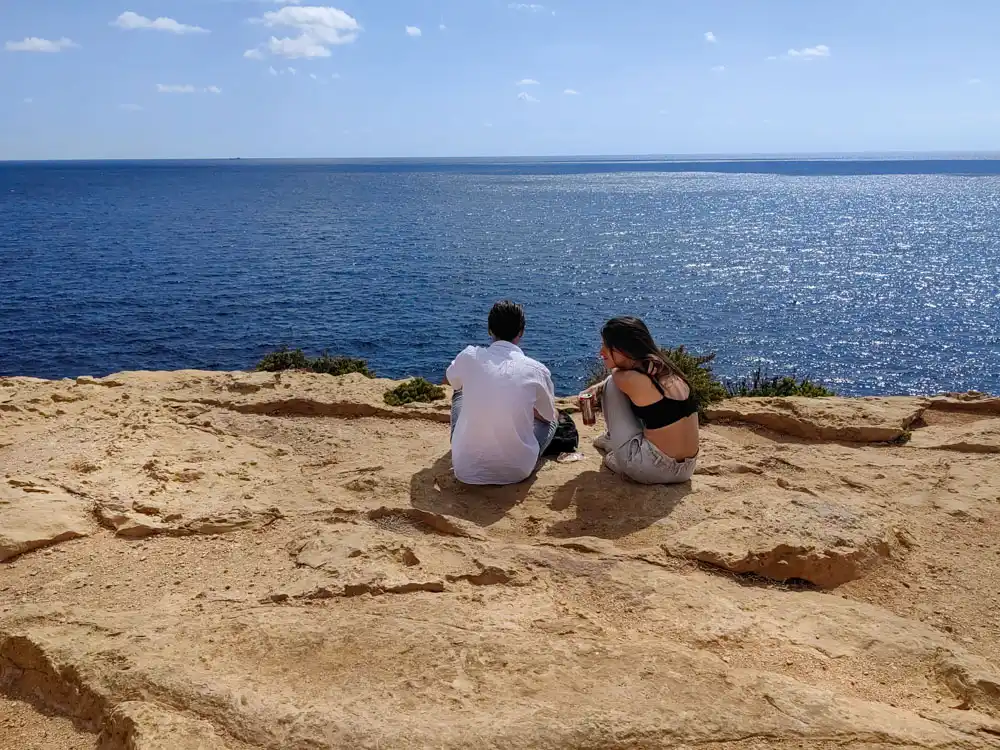


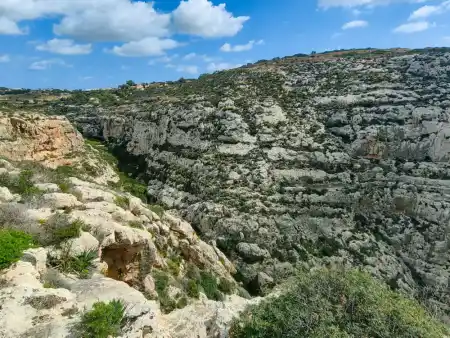
Blue Grotto trail canyon from Qrendi village to the sea is solidly challenging
Blue Grotto trail
I’m always looking for a reason to take a beautiful trail. Seeing from above is not enough. You can already reach the canyon from the village of Qrendi to the sea level.
Head the other way from the bus stop towards the village after about three-quarters of a kilometre. You will find the entrance to the canyon. This will take you along a beautiful trail to the sea. Unfortunately, there is an end. You can’t get to the caves and must go back the same way.
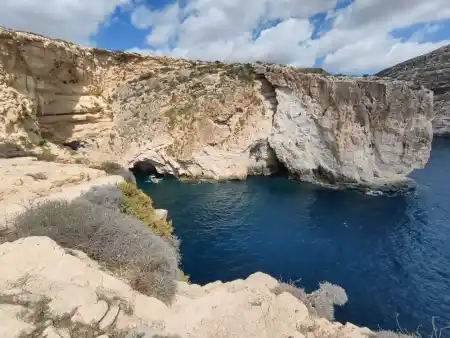

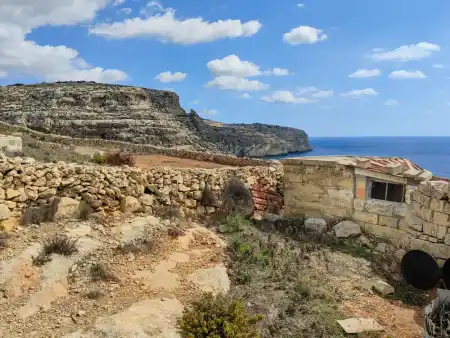
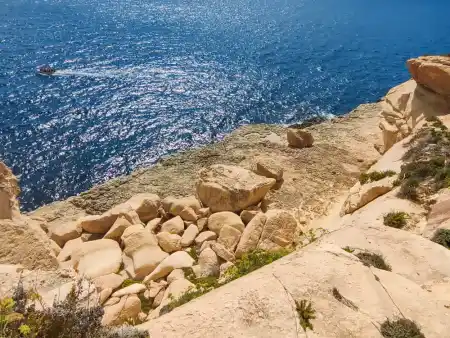
From the olive trees to the rock reef
However, the most amazing experience was the unofficial path between the Panorama lookout along the cliffs to the tower in the village of Zurrieg.
Don’t be discouraged
Private property did not discourage me. On the contrary, I admired Maltese farmers’ creativity in creating magical garden nooks. I wonder what the Maltese grow on these rocky plantations besides evening parties.
First, I overcame physical and mental barriers like “No trespassing, danger of falling, unsecured rocks, private property,….” Those views and the adrenaline rush at the edge of the cliffs just overcame my responsibility.
I stopped right above sea level. At last, complete silence, broken only by the cawing of birds. I found only one extremely independent teal and a pair of rattlesnakes on the whole path. They obviously had something to say to each other.
In the distance, I saw a bubbling circle on the surface: “Did the Nordstream go through Malta too?” But where. That was just a maniac on a speedboat getting crazy. Maybe he wanted to impress us, but the speed with which he disappeared was remarkable.

Wied Iž Zurrieg
Here is a small harbour where you can be put on a boat and taken around the rock caves for 8 euros.
Don’t hesitate. It’s a great experience, especially if you catch a chatty group and a crosswind. However, the locals have everything under control. They ride all the time. After all, that’s what they live on.

In the Blue Grotto Caves
A boat ride through the caves is an extraordinary experience. The caves are illuminated from below, and the surface reflects millions of tones of blue on the walls and ceilings, depending on the angle and position of the sun. Hence the name blue cave. The brilliant phosphorescent colours of the attached corals and small animals complement the colours.
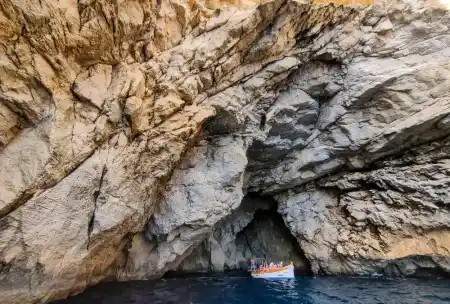



Inside the caves
Each cave is different and highly photogenic. If you can find the space and sneak a clear shot through the outstretched hands with the smartphones of other photo hunters on the boat.
The Blue Grotto has also been frequently rotated by major film crews. Films such as Hell Boats and Troy were shot here. The Blue Grotto also works in marketing and advertising, much like the American Marlboro Man.
The passage under the Blue Grotto itself is awe-inspiring.
The guide also spiced up his steering jokes with some useful geological information. The photo above shows us the various sediment deposits and rock structures responsible for the formation of the caves. The rugged granite (granite) forms a solid base, and the rock deposits and crumbling sandstone in the higher layers, constantly being washed away by the sea, form the rock windows we admire.
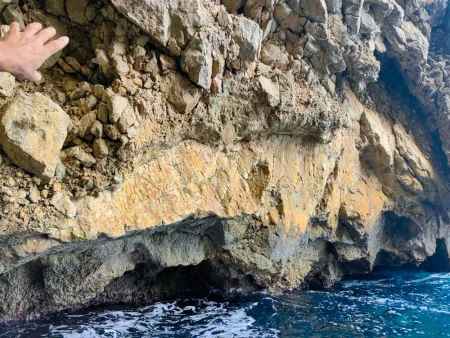


Snorkelling and diving
It also invites us to a diving experience. Diving on the nearby sunken wreck of Um El Faroud and snorkelling along the coast. I politely decline. I still need to do my 10km today.
On the way back, I’ll enjoy the Blue Grotto in all its glory again. Seeing those overhangs and imagining that I’ve skirted those reefs a metre from the edge, it occurs to me that I should weigh considerably less. 🙂 Or respect the signs more: “Caution no trespassing, unstable unsecured cliff.”
When one sees the tourist hustle and bustle, one has to wonder what Malta looked like a hundred years ago. Do you want to get a glimpse of Malta 100 years ago? Click here.
I bid farewell to the Blue Grotto with a genre tourist boat photo, with the longing that we need to come back here. But then I realise that there are many similar beautiful places worldwide. Bugibba or the nearby Dingli Cliffs, for example. Never mind, at least I’ll dip in the local lagoon.

Hagar Qim
Just a kilometre from the Blue Grotto towards Gozo is the crucial archaeological temple area of Hagar Qim.
It dates from between 3600 and 3000 BC. I’ll save that one for next time. The area consists of 4 megalithic temples and is one of Malta’s most famous tourist attractions. If I get here, it’s definitely worth exploring in detail.



